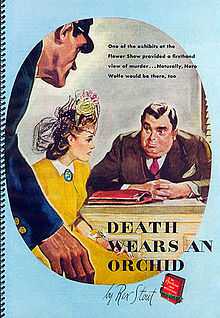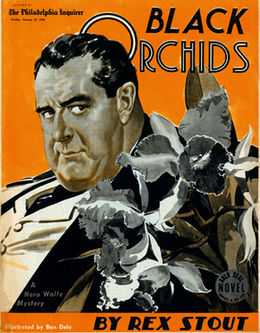Black Orchids (novella)
| "Black Orchids" | |
|---|---|
 Illustrated by Fred Ludekens | |
| Author | Rex Stout |
| Original title | "Death Wears an Orchid" |
| Country | United States |
| Language | English |
| Series | Nero Wolfe |
| Genre(s) | Detective fiction |
| Published in | The American Magazine |
| Publication type | Periodical |
| Publication date | August 1941 |
"Black Orchids" is a Nero Wolfe mystery novella by Rex Stout, first published in abridged form as "Death Wears an Orchid" in the August 1941 issue of The American Magazine. It first appeared in book form in the short-story collection Black Orchids, published by Farrar & Rinehart in 1942.
Plot summary
The dick got out his memo book and wrote it down. "I don't think it was deliberate," he said. "I think she just changed her mind. I think she just – "
"You think? You say you think?"
"Yes, Inspector, I – "
"Get out. Take another man, take Dorsey, and go to that address and look into her. Don't pick her up. Keep on her. And for God's sake don't think. It's repulsive, the idea of you thinking."— Inspector Cramer to a subordinate, in "Black Orchids"
Millionaire orchid fancier Lewis Hewitt has hybridized three black orchid plants in his Long Island greenhouse. Nero Wolfe is wild to have one, so he and Archie Goodwin visit New York's annual flower show, where Hewitt's orchids are on exhibit. One of the other exhibits features a daily performance by a young couple miming a summer picnic. The woman, Anne Tracy, attracts the attentions of Archie, Lewis Hewitt, Billy Rose and a young exhibitor named Fred Updegraff.
During Wolfe's visit to the show, Anne's picnic partner Harry Gould is killed, shot in the head by a gun concealed in the foliage. The gun's trigger is attached to a long string that reaches to a hallway well behind the exhibit.
After a little inquiry, Wolfe shows Hewitt how his expensive Malacca cane was used to pull the string, thus the gun's trigger, and thus to kill Gould. Hewitt is horrified by the prospect of the publicity that would ensue should his part in the shooting, however indirect and unwitting, become known. Wolfe offers Hewitt this arrangement: in exchange for all three black orchid plants, the only ones in existence, Wolfe will solve the murder and deliver the criminal to the police, without publicly disclosing Hewitt's connection to the crime. Hewitt terms it blackmail, but submits.
Earlier, Archie had noticed a woman waiting in the hallway behind the exhibit, at around the time that the murderer would have been deploying the string. He now finds her in the crowd that's gawking at the murder scene. In an act of detection that would strain the credulity of someone who was striving to maintain a neutral point of view, Archie steals her handbag, removes it to the men's room, searches it for identification, and learns her name (Rose Lasher) and address. He returns the handbag to her – all without Miss Lasher or anyone else noticing.
The police want to know more about her and, finishing their questions, they let her go — but surreptitiously follow her. The police lose her trail but Archie knows her home address, where she has been living with Harry Gould. He arrives at Miss Lasher's apartment just as she is about to flee the city, and takes her to Wolfe's house. There Archie searches her suitcase and finds some printed matter that Rose cannot or will not explain: a clipping of an article by Lewis Hewitt on Kurume yellows,[1] a plant disease that is fatal to broadleaf evergreens; a postcard to Rose from Harry, postmarked Salamanca, New York (in the western part of the state); and a work order from a garage, also in Salamanca.
Wolfe gets Miss Lasher to discuss some of Gould's unsavory qualities. Wolfe learns that although Gould was employed as a gardener, he suddenly acquired a bank account containing several thousand dollars[2] and what Miss Lasher terms "a big roll of bills."
From his general awareness of horticultural events, Wolfe knows that an attack of Kurume yellows devastated a plantation of a new hybrid of broadleaf evergreens, about eighty miles west of Salamanca and owned by Updegraff Nurseries.
Weighing all this information, Wolfe concludes that Gould had known the Updegraff plantation had been deliberately infected, and was blackmailing the miscreant – who then killed Gould. Wolfe gathers the main players in an appropriate location – his plant rooms, specifically the fumigating room – and exposes the murderer's identity. Wolfe therefore keeps the black orchids, which subsequently have a cameo role in the second novella in this collection, "Cordially Invited to Meet Death"
Cast of characters
- Nero Wolfe — The private investigator
- Archie Goodwin — Wolfe's assistant (and the narrator of all Wolfe stories)
- Anne Tracy — Secretary at the Rucker and Dill nursery company, and the star of the company's Flower Show exhibit
- Harry Gould — Greenhouse man at Rucker and Dill, the exhibit's co-star, and murder victim
- W. G. Dill — Their employer
- Fred Updegraff — Nursery owner, exhibitor, and Miss Tracy's would-be beau
- Rose Lasher — Harry Gould's live-in girlfriend
- Lewis Hewitt — Wealthy owner and exhibitor of the only three black orchid plants in existence[3]
- Inspector Cramer and Sergeant Purley Stebbins — Representing Manhattan Homicide
Publication history

one of only four Rex Stout stories issued as a
Gold Seal Novel by The Philadelphia Inquirer
(January 10, 1943)
"Black Orchids"
- 1941, The American Magazine, August 1941, abridged as "Death Wears an Orchid"[4]
- 1943, The Philadelphia Inquirer, a Gold Seal Novel, January 10, 1943
- New York: Lawrence E. Spivak, American Mercury #72, not dated, paperback
- 1945, Rex Stout Mystery Quarterly #1, May 1945
- 1950, New York: Avon #256 (as "The Case of the Black Orchids"), 1950, paperback
- 1967, The Saint Magazine, January 1967
- 1996, Burlington, Ontario: Durkin Hayes Publishing, DH Audio ISBN 0-88646-889-2 December 1996, audio cassette (unabridged, read by Saul Rubinek)
Black Orchids
- 1942, New York: Farrar & Rinehart, May 21, 1942, hardcover[5]
- Contents include "Black Orchids" and "Cordially Invited to Meet Death".
- In his limited-edition pamphlet, Collecting Mystery Fiction #9, Rex Stout's Nero Wolfe Part I, Otto Penzler describes the first edition of Black Orchids: "Brick brown cloth, front cover and spine printed with black; rear cover blank. Issued in a brick brown and green pictorial dust wrapper … The first edition has the publisher's monogram logo on the copyright page."[6]
- In April 2006, Firsts: The Book Collector's Magazine estimated that the first edition of Black Orchids had a value of between $3,000 and $5,000. The estimate is for a copy in very good to fine condition in a like dustjacket.[7]
- 1942, Toronto: Oxford University Press, 1942, hardcover
- 1942, New York: Detective Book Club #5, August 1942, hardcover
- 1943, London: Collins Crime Club, July 5, 1943, hardcover
- 1943, New York: Grosset & Dunlap, 1943, hardcover
- 1945, Cleveland, Ohio: World Publishing Company, a Tower Book, March 1945, hardcover
- 1946, New York: Avon #95, 1946, paperback
- 1963, New York: Pyramid (Green Door) #R-917, September 1963, paperback
- 1992, New York: Bantam Crimeline ISBN 0-553-25719-6 May 1992, trade paperback
- 1996, Burlington, Ontario: Durkin Hayes Publishing, DH Audio, "Black Orchids" ISBN 0-88646-889-2 December 1996, audio cassette (unabridged, read by Saul Rubinek)
- 1998, Burlington, Ontario: Durkin Hayes Publishing, DH Audio ISBN 0-88646-472-2 August 1998, audio cassette (abridged; CBC Radio drama, "Cordially Invited to Meet Death")
- 2009, New York: Bantam Dell Publishing Group (with The Silent Speaker) ISBN 978-0-553-38655-4 August 25, 2009, trade paperback
- 2010, New York: Bantam Crimeline ISBN 0-307-75573-8 June 30, 2010, e-book
References
- ↑ The Kurume yellows is apparently a fictional disease. Its name is not located by various Internet search engines in other than discussions of this novella.
- ↑ Bear in mind the publication date, 1942.
- ↑ Also, occasional participant in subsequent Wolfe stories, twice in his capacity as a member of the Ten for Aristology, once as the guardian of Wolfe's orchids (In the Best Families), once to provide help when Wolfe's plant rooms are shot up (The Second Confession), and once to recommend Andy Krasicki as a stand-in for Theodore ("Door to Death").
- ↑ Townsend, Guy M., Rex Stout: An Annotated Primary and Secondary Bibliography (1980, New York: Garland Publishing; ISBN 0-8240-9479-4), pp. 56–57. John McAleer, Judson Sapp and Arriean Schemer are associate editors of this definitive publication history.
- ↑ Townsend, Guy M., Rex Stout: An Annotated Primary and Secondary Bibliography (1980, New York: Garland Publishing; ISBN 0-8240-9479-4), pp. 79–80
- ↑ Penzler, Otto, Collecting Mystery Fiction #9, Rex Stout's Nero Wolfe Part I (2001, New York: The Mysterious Bookshop, limited edition of 250 copies), pp. 17–18
- ↑ Smiley, Robin H., "Rex Stout: A Checklist of Primary First Editions." Firsts: The Book Collector's Magazine (Volume 16, Number 4), April 2006, p. 33
External links
![]() Quotations related to Black Orchids at Wikiquote
Quotations related to Black Orchids at Wikiquote